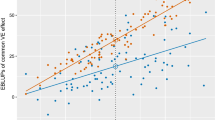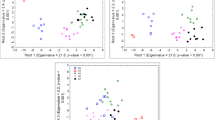Abstract
Canonical Discriminant Analysis was investigated as a means of assessing the merit of crosses in relation to established commercial cultivars and breeding goals. The progeny (30 per cross) of 22 crosses was evaluated in field plots at the Vauxhall Substation of the Lethbridge Research Station (Alberta). Mean values of the progeny of each cross for vine maturity, marketable yield, tuber size, tuber appearance and specific gravity were used to measure the overall merit of crosses in comparison to commercial cultivars. Breeding goals were established by calculating a 10% improvement in various combinations of the traits measured and then substituting these values in the canonical equations and computing theoretical values for the canonical variates.
The canonical diagrams provided a precise and logical assessment of the relationship among cross means, control cultivars, and the breeding goals. Based on the evaluation of the 22 crosses, breeding goals for improvements in vine maturity, tuber size, marketable yield, and specific gravity over trait values obtained for Norchip and Russet Burbank, were realistic for the 1979 cross series but not for Norchip for 1980.
Compendio
Se investigó el análisis canónico discriminativo como un medio para determinar los méritos de los cruzamientos en relación con cultivares comerciales establecidos y metas de mejoramiento. Las progenies (30 por cruzamiento) de 22 cruzamientos fueron evaluadas en parcelas de la Subestación Vauxhall de la Estación Experimental de Lethbridge (Alberta). Los valores promedio de la progenie de cada cruzamiento para madurez, rendimiento comerciable, tamaño de tubérculo, apariencia de tubérculo, y gravedad específica, fueron utilizados para medir el mérito total de los cruzamientos en comparación con los cultivares comerciales. Se establecieron metas de mejoramiento calculando un 10% de mejoramiento en varias combinaciones de los atributos medidos, sustituyendo estos valores en ecuaciones canónicas y computando los valores teóricos para las variables canónicas. Los diagramas canónicos permitieron determinar precisa y lógicamente la relación entre los promedios de cruzamientos, cultivares testigo, y metas de mejoramiento. Basándose en la evaluación de los 22 cruzamientos, las metas de mejoramiento para madurez de planta, tamaño de tubérculo, rendimiento comerciable y gravedad específica, sobre los valores obtenidos para los diversos atributos de los cultivares Norchip y Russet Burbank fueron realistas para las series de cruzamientos de 1979, pero no así para Norchip en 1980.
Similar content being viewed by others
Literature Cited
Gilbert, N.E.G. 1958. Diallel cross in plant breeding. Heredity 12:477–492.
Lin, C.S. and G. Pouschinsky. 1983. A modified augmented design for an early stage of plant selection involving a large number of test lines without replication. Biometrics 39:553–561.
Lynch, D.R., G.C.C. Tai, D.A. Young and G.B. Schaalje. 1983. Effect of selecting potato seedlings under Maritime conditions on the performance of the first clonal generation under Prairie conditions. Am Potato J 60:607–615.
Plaisted, R.L., L. Sanford, W.T. Federer, A.E. Kerr and L.C. Peterson. 1962. Specific and general combining ability for yield in potatoes. Am Potato J 39:185–197.
Sarle, W.S. 1985. CANDISG. SAS User’s Guide: Statistics, Version 5 ed. SAS Institute Inc., Cary, North Carolina. p. 155–170.
Schaalje, G.B., D.R. Lynch and G.C. Kozub. 1987. Field evaluation of a modified augmented design for early stage selection involving a large number of test lines without replication. Potato Res 30:(in press).
Tai, G.C.C. 1976. Estimation of general and specific combining abilities in potato. Can J Genet Cytol 18:463–470.
Whitehouse, R.N.H. 1963. Canonical analysis as an aid in plant breeding.In: Nilan, R.A. (ed.). Barley Genetics II. Proceedings of the Second International Barley Genetics Symposium, Washington State Univ. Press. pp. 269–282.
Author information
Authors and Affiliations
Rights and permissions
About this article
Cite this article
Lynch, D.R., Schaalje, G.B., Tai, G.C.C. et al. Use of canonical discriminant analysis in assessing the merit of crosses in terms of breeding goals. American Potato Journal 64, 385–395 (1987). https://doi.org/10.1007/BF02853700
Accepted:
Issue Date:
DOI: https://doi.org/10.1007/BF02853700




